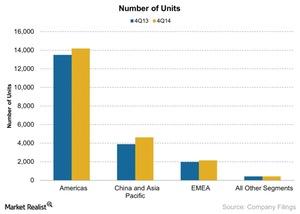Starbucks’s Geographic Segment Update
The following are Starbucks’s geographic segments: Americas; China and Asia Pacific; and Europe, the Middle East, and Africa.
Jan. 27 2015, Updated 1:06 p.m. ET

Starbucks’s main market segments
In the previous part of this series, we saw that Starbucks Corporation’s (SBUX) aggressive unit growth has had a more pronounced effect on revenues than same-store sales. Starbucks operates several stores globally. The following are Starbucks’s geographic segments: the Americas; China and Asia Pacific (or CAP); and Europe, the Middle East, and Africa (or EMEA).
Focus on CAP segment
Starbucks is focusing heavily on China, where it has almost 1,400 stores. The company is expected to rapidly expand its mobile and loyalty ecosystem in China. Starbucks has a strong potential in China where its same-store sales growth is outpacing its segment. During the last quarter earnings call, Starbucks’s management stated that it’s adding one store a day in China, which should continue in the coming years.
This segment also includes about 1,000 stores in Japan. The company stated it will continue to drive the digital strategy in Japan. It will be interesting to see how this segment has performed in the upcoming earnings release.
The EMEA segment
In the previous quarter, Starbucks’s EMEA segment performed well. The company claimed this was a result of its turnaround strategy, especially in the United Kingdom. Europe in particular has been challenging for several restaurants, including McDonald’s Corporation (MCD), Yum! Brands (YUM), and a few of those included in the Consumer Discretionary Select Sector SPDR ETF (XLY).
Like Starbucks, Dunkin’ Brands (DNKN) is also pushing units and digital strategy outside the United States, which is yet to see similar levels of success.
So what is the digital strategy Starbucks (SBUX) is driving after all? Let’s look at that next.
